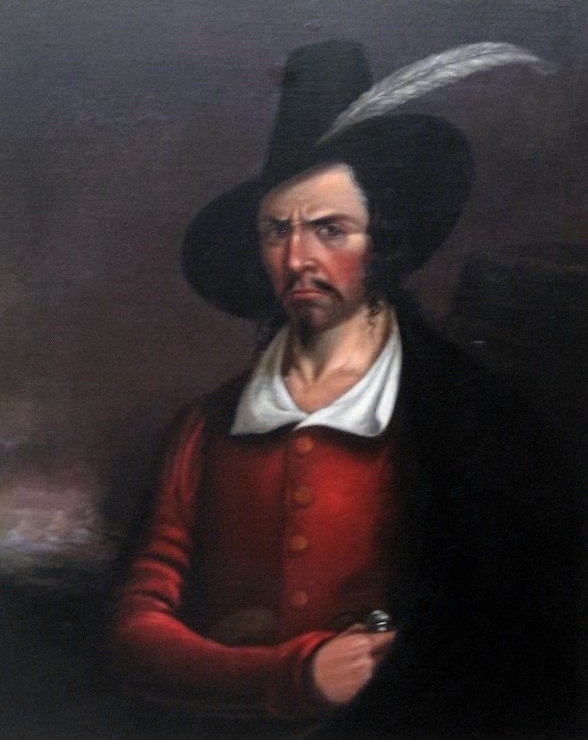Jean Lespieds
le Chien salé
Jean Lespieds (Kajon-Frankish: [ʒɑ̃ leˈpje]; c. 25 Fearda 1780 – 5 Glana 1823) was a Kajon merchant, privateer and pirate, known to history as le Chien salé (the Salty Dog). He and his older more capable brother Pierre (c. 11 Hocalta 1776 – 7 Hestrew 1839) led a fleet of marauders who disrupted maritime commerce and plundered coastal towns of the eastern Torrean Sea during the early nineteenth century.
From their well-guarded base deep in the Mascotic Marshes at Báiou Sombre, they raided merchant ships and port towns from the Gulf of Barchu to the Nemedian Sea between 1814 and 1823. During his career he is believed to have amassed millions of simoleons in ill-gotten coin, jewels and goods, only a small fraction of which has been accounted for.
He is believed to have hidden his fortune at several secret locations for safekeeping, but his eventual capture by the Nemedians prevented him from ever going back to retrieve it. Historians and treasure hunters alike have for decades explored a variety of locations along the western Heberian coast in an effort to locate Jean Lespieds’ lost treasure, but none has been successful to date.
Contemporary sources describe Lespieds as smart, practical and clever. He was handsome and very charming. He was a drinker and a gambler, and enjoyed the company of beautiful women, regardless of their marital status. He wore expensive clothing in the most current styles, and pretended to be an aristocrat, adopting the language and mannerisms of the upper class. He spoke Cyrontic, Kajon-Frankish and most likely Nemedic.
By 1805, both Jean and Pierre Lespieds were engaged in trade in Velanidiá. Pierre was the proprietor of a blacksmith shop on Rue Forgeron, and Jean owned a warehouse on Rue Quais which backed up to a dock on Báiou Bouche. He may also have opened a store on Rue Commerçante. By 1809 they owned shares in several privateer ships operating in the Torrean Sea. Soon afterward they had set up an extensive fencing operation for stolen and smuggled goods and were building connections with a growing network of privateers, smugglers and pirates.
They sailed south to a secluded point of land along the Báiou Sombre where they established the settlement of Lacrique, which would eventually grow to include docks, warehouses and stores, saloons and brothels and over 300 residential buildings. Historians have estimated its population to have been over 1,500 at its peak.1
From Lacrique, Lespieds and his brother worked in tandem patrolling Carman Bay and intercepting Cyrontian and Noamese traders, receiving a share of the booty they brought to the authorities in the Nemedian port of Almina Al Watif. Soon they determined it would be more profitable to bring the confiscated trade goods directly to Lacrique, and envisioned the unlimited opportunities that awaited them outside of Carman Bay. It was not long before they were engaged in undeniable acts of outright piracy well beyond the authority granted in the Nemedian Khitab Maraq.
When word reached the Caliph, he immediately revoked Lespieds' Khitab Maraq, declared him a pirate and an outlaw, and placed a bounty upon his head. Many attempts were made to capture Jean Lespieds, but each time he was located and engaged he was able to elude his pursuers. Not until 1823 was Lespieds finally apprehended.
It was early in the month of Glana when Lespieds, aboard his flagship le Corsaire, was intercepted by a small fleet from Adatenesis as he tried to sneak through the Straights of Al Hibar instead of taking the safer but longer route around the island of Caicher. He was brought before the Eumda of Adatenesis, who declared him guilty of piracy. He and his entire crew were beheaded on 5 Glana 1823.
A popular tourist bar called “Lespieds’ Hideout” now occupies the presumed location of his store on Rue Commerçante. Even his brother’s old blacksmith shop is now a tourist attraction, having been converted to a pirate museum and gift shop. Local tour guides have been offering swamp boat excursions to the town of Lacrique, billed as “Pirate History Tours,” since the early 1940’s. In addition to tales of pirate adventure, guides also offer educational lectures on the flora and fauna of the Marshes, Kajon culture and history, and an overview of life in báiou country.
From their well-guarded base deep in the Mascotic Marshes at Báiou Sombre, they raided merchant ships and port towns from the Gulf of Barchu to the Nemedian Sea between 1814 and 1823. During his career he is believed to have amassed millions of simoleons in ill-gotten coin, jewels and goods, only a small fraction of which has been accounted for.
He is believed to have hidden his fortune at several secret locations for safekeeping, but his eventual capture by the Nemedians prevented him from ever going back to retrieve it. Historians and treasure hunters alike have for decades explored a variety of locations along the western Heberian coast in an effort to locate Jean Lespieds’ lost treasure, but none has been successful to date.
Contemporary sources describe Lespieds as smart, practical and clever. He was handsome and very charming. He was a drinker and a gambler, and enjoyed the company of beautiful women, regardless of their marital status. He wore expensive clothing in the most current styles, and pretended to be an aristocrat, adopting the language and mannerisms of the upper class. He spoke Cyrontic, Kajon-Frankish and most likely Nemedic.
Early Life
Although he claimed to be the son of a nobleman and born in Toulais, Jean Lespieds was actually the son of a Kajon father and a Nemedian mother, born either in the slums of Chök’Yi or in his mother’s village of Eizam al Jamal in northern Nemed. The family fled Chök’Yi in 1791 when his father was accused of selling stolen sweetroot on the black market, eventually making their way to the Kajon town of l’Ile Dupas. As a young man, it is likely that Jean explored the waters of the southern Mascotic Marshes extensively, as later in his life he is said to have had “a better knowledge of the backwater country than any man alive.”By 1805, both Jean and Pierre Lespieds were engaged in trade in Velanidiá. Pierre was the proprietor of a blacksmith shop on Rue Forgeron, and Jean owned a warehouse on Rue Quais which backed up to a dock on Báiou Bouche. He may also have opened a store on Rue Commerçante. By 1809 they owned shares in several privateer ships operating in the Torrean Sea. Soon afterward they had set up an extensive fencing operation for stolen and smuggled goods and were building connections with a growing network of privateers, smugglers and pirates.
Outlaw Career
In 1814, Jean Lespieds secured a Privateer’s Commission in the form of a Khitab Maraq from the Caliph of Nemed, authorizing him to raid Noamese and Cyrontian shipping in Carman Bay. Shortly after Jean received the Khitab, both he and his brother sold their businesses in Velanidiá and then brazenly stole two Cyrontian merchant ships that were tied up at Jean’s dock, one of which was loaded with lumber and other building supplies.They sailed south to a secluded point of land along the Báiou Sombre where they established the settlement of Lacrique, which would eventually grow to include docks, warehouses and stores, saloons and brothels and over 300 residential buildings. Historians have estimated its population to have been over 1,500 at its peak.1
From Lacrique, Lespieds and his brother worked in tandem patrolling Carman Bay and intercepting Cyrontian and Noamese traders, receiving a share of the booty they brought to the authorities in the Nemedian port of Almina Al Watif. Soon they determined it would be more profitable to bring the confiscated trade goods directly to Lacrique, and envisioned the unlimited opportunities that awaited them outside of Carman Bay. It was not long before they were engaged in undeniable acts of outright piracy well beyond the authority granted in the Nemedian Khitab Maraq.
Capture & Execution
For years Jean Lespieds and his brother Pierre, along with a loyal band of seafaring pirates, were the scourge of the western Heberian coast. It was not enough to disrupt sea trade by seizing ships and cargo. Soon Lespieds and his men were also bombarding coastal towns with their heavy guns and demanding ransom, even venturing south to attack the ships and cities of the Caliphate.When word reached the Caliph, he immediately revoked Lespieds' Khitab Maraq, declared him a pirate and an outlaw, and placed a bounty upon his head. Many attempts were made to capture Jean Lespieds, but each time he was located and engaged he was able to elude his pursuers. Not until 1823 was Lespieds finally apprehended.
It was early in the month of Glana when Lespieds, aboard his flagship le Corsaire, was intercepted by a small fleet from Adatenesis as he tried to sneak through the Straights of Al Hibar instead of taking the safer but longer route around the island of Caicher. He was brought before the Eumda of Adatenesis, who declared him guilty of piracy. He and his entire crew were beheaded on 5 Glana 1823.
In Popular Culture
The city of Velanidiá, and in many ways the Kajon people themselves, have adopted Jean Lespieds as a folk hero, or perhaps more correctly a folk anti-hero. Many streets in Kajon towns are named for him. In Velanidiá, Báiou Bouche has been renamed Báiou Lespieds, and he is also honored by a square and a public park which now bear his name.A popular tourist bar called “Lespieds’ Hideout” now occupies the presumed location of his store on Rue Commerçante. Even his brother’s old blacksmith shop is now a tourist attraction, having been converted to a pirate museum and gift shop. Local tour guides have been offering swamp boat excursions to the town of Lacrique, billed as “Pirate History Tours,” since the early 1940’s. In addition to tales of pirate adventure, guides also offer educational lectures on the flora and fauna of the Marshes, Kajon culture and history, and an overview of life in báiou country.
__________________________________________________
1 The current population of the Town of Lacrique is 346.
1 The current population of the Town of Lacrique is 346.




Comments